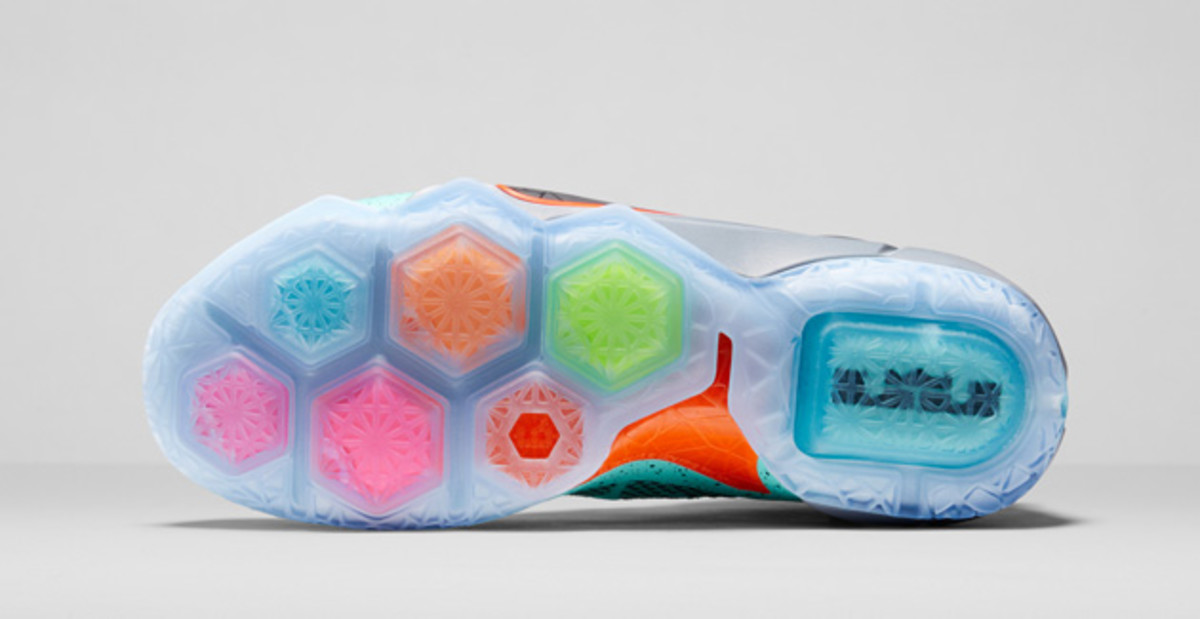The evolution—straight into the LeBron 12—of Nike Air Zoom

Nike believes in the natural power of the hexagon, its ability to morph quickly and naturally adapt. Fill that hexagon with Nike’s Zoom Air system and Taryn Hensley, Nike’s cushioning innovation director, tells Edge you get an “incredibly responsive, snappy, bouncy” cushioning system.
The Nike Air Zoom isn’t new, first launching in 1995. But it is fresh. The new LeBron 12—set for an Oct. 11 launch, but “a small cosmetic issue” during production, according to a Nike spokesperson, has delayed the release—features the Zoom in the new-to-Nike hexagonal pattern, mapped to specific pressure points under the foot. And an Oct. 10 release of the Nike Zoom Hypercross Trainer also highlights the hex Zoom Air, but with a completely different arrangement under foot.
Why the Panthers' Thomas DeCoud owns hundreds of shoes
Hensley says the benefit of Nike’s in-house Sports Research Lab and its force-plate technology allowed the cushioning team to take pinpoint measurements of the pressure the foot sees when in different motions, whether basketball or training. “We wanted to be able to specifically map the Zoom cushioning under the foot that was specific to the motion of the athlete,” Hensley says. “The LeBron 12 is the pressure map of the basketball player.”
The hexagonal shapes on the sole of the LeBron 12 offer different sizes and thicknesses, customized to the pressure map generated in the lab, giving “cushioning exactly where needed.”
To allow the foot to move more naturally, the hex shape was required. “We go back to the power of the hex shape in nature,” Hensley says. “It maps and morphs very well. Try to imagine taking a bunch of squares and putting them under foot. It doesn’t work as naturally as the hex shape does.”
And since a foot isn’t flat, Hensely’s team created different sizes and thicknesses throughout the foot, with the most pronounced cushioning coming under the largest bone in the foot: the heel, which often produces the most pressure.

But why use Nike Zoom Air at all? Nike also has foam cushioning and a different air system, the Max Air. What sets Zoom apart is a series of polyester or nylon fibers highly tensioned inside the Zoom air bag (Max Air doesn’t have fibers and the tiny bubbles that make up foam break down over time).
The fibers themselves prove common in both the apparel and automotive industry, but the way Nike uses them offers a different application. Think of a sandwich, Hensley says, with two layers of bread. Nike, with a needle and thread, creates vertical fibers inside two solid layers—your bread—adhering the layers together. When the sewn-together air bag gets pressurized in the Zoom system it pushes the fibers into high tension.
“The automotive or apparel industry is wanting fibers to be loose and soft and flex and we want them to be in very high tension,” Hensley says. “What that does is when the foot comes down, it provides good cushioning and protection and when the foot comes off, the fibers snap back into a highly tensioned position.” With thousands of these fibers in a single Zoom Air bag, the snapping back allows each bag to maintain high-tension pressure over hours of wear.
House of Jordan: Getting the full experience in the Air Jordan XX9
With the adapted technology comes a changing aesthetic. A traditional outsole would restrict the hex-shaped Zoom bags’ ability to move naturally and independently, thus ruining “the intent of the system.” Instead, such as in the LeBron 12, the clear outsole—which shows off the brightly colored hex patterns—covers the entire underfoot of the shoe, but with deep flex grooves so the air bag can flex. The Hypercross has an independent pod look with outsole capping for traction and durability.
The hex shape has now appeared in two completely new shoes, both with their own unique pressure-mapping system. Expect to see Nike embrace the hex even more. “It is one of those technologies that can scale or transfer into different sports,” Hensley says. “We might have to do even more sizes, different fibers and different heights.”
All along, the natural hex will morph with your pressure.
Tim Newcomb covers stadiums, design and gear for Sports Illustrated. Follow him on Twitter at @tdnewcomb.
